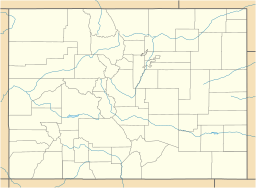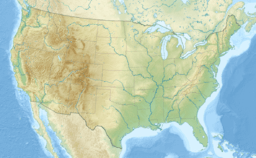Gross Reservoir facts for kids
Quick facts for kids Gross Reservoir |
|
|---|---|

The reservoir in 2014.
|
|
| Location | Boulder County, Colorado |
| Coordinates | 39°56′31″N 105°22′22″W / 39.94194°N 105.37278°W |
| Type | reservoir |
| Etymology | Named for Denver Water former Chief Engineer Dwight D. Gross. |
| Primary outflows | South Boulder Creek |
| Basin countries | United States |
| Managing agency | Denver Water |
| Surface area | 440 acres (180 ha) |
| Water volume | 41,811 acre⋅ft (51,573,000 m3) |
| Surface elevation | 2,222 m (7,290 ft) |
Gross Reservoir is a large reservoir located in Boulder County, Colorado. It is managed by Denver Water, which provides water to many people. This reservoir was finished in 1954. It covers an area of about 440 acres, which is like 330 football fields! The top of its spillway, where extra water flows out, is at an elevation of 7,225 feet.
The reservoir gets its water from South Boulder Creek and from the western side of the Continental Divide. Water from the Continental Divide travels through the Moffat Tunnel to reach the reservoir. Water then flows out of the 340-foot-high dam into South Boulder Creek.
Contents
Fun Activities at Gross Reservoir
Gross Reservoir is a great place for outdoor fun! You can enjoy many activities here, like fishing, including ice fishing in winter. It's also a popular spot for hiking, canoeing, and kayaking. Some areas are available for camping too.
It's important to remember that for safety and water quality, you cannot swim or wade in the reservoir. Only boats without motors are allowed on the water. This helps keep the water clean and safe for everyone.
Gross Reservoir Expansion Project
A big project has been underway to make Gross Reservoir even larger. This expansion allows Denver Water to store much more water, about 77,000 additional acre-feet. Most of this extra water comes from the Fraser and Williams Fork Rivers.
The construction work involves raising the dam's height by 131 feet. This will make Gross Dam the tallest dam in Colorado. The project was expected to be completed around 2027.
Approvals and Environmental Concerns
To build the expansion, Denver Water needed special permits. They received a permit from the U.S. Army Corps of Engineers in 2017. This permit is required under the Clean Water Act, a law that protects our water.
Some environmental groups were concerned about the project's impact on nature. They filed lawsuits, saying that the process for granting the permit did not fully follow laws like the Clean Water Act, the Endangered Species Act, and the National Environmental Policy Act.
In July 2020, the Federal Energy Regulatory Commission also approved a change to the original license for Gross Dam. This was another important step for the project to move forward.
Local Approvals and Agreements
Boulder County also required Denver Water to get a special land use permit for the expansion. Denver Water applied for this permit in September 2020. In 2021, the Boulder County commissioners approved the expansion. They also agreed to a $12.5 million deal for environmental protection. This money helps to reduce any negative effects the project might have on the environment.
Climate at Gross Reservoir
The weather at Gross Reservoir can vary a lot! The hottest temperature ever recorded there was 94°F (34°C). This happened on several dates, including July 9, 2003, and June 22, 2016. The coldest temperature recorded was a chilly -24°F (-31°C) on February 2, 2011.
| Climate data for Gross Reservoir, Colorado, 1991–2020 normals, extremes 1978–present | |||||||||||||
|---|---|---|---|---|---|---|---|---|---|---|---|---|---|
| Month | Jan | Feb | Mar | Apr | May | Jun | Jul | Aug | Sep | Oct | Nov | Dec | Year |
| Record high °F (°C) | 67 (19) |
64 (18) |
72 (22) |
78 (26) |
89 (32) |
94 (34) |
94 (34) |
92 (33) |
91 (33) |
81 (27) |
70 (21) |
64 (18) |
94 (34) |
| Mean maximum °F (°C) | 57.7 (14.3) |
58.1 (14.5) |
66.3 (19.1) |
72.3 (22.4) |
78.7 (25.9) |
88.0 (31.1) |
89.8 (32.1) |
87.7 (30.9) |
84.7 (29.3) |
75.5 (24.2) |
66.5 (19.2) |
58.1 (14.5) |
91.0 (32.8) |
| Mean daily maximum °F (°C) | 39.3 (4.1) |
39.7 (4.3) |
47.2 (8.4) |
52.2 (11.2) |
60.8 (16.0) |
72.6 (22.6) |
79.3 (26.3) |
77.1 (25.1) |
69.7 (20.9) |
56.8 (13.8) |
47.0 (8.3) |
39.5 (4.2) |
56.8 (13.8) |
| Daily mean °F (°C) | 28.1 (−2.2) |
28.2 (−2.1) |
34.7 (1.5) |
39.7 (4.3) |
48.1 (8.9) |
58.1 (14.5) |
64.5 (18.1) |
62.3 (16.8) |
55.2 (12.9) |
44.1 (6.7) |
35.3 (1.8) |
28.5 (−1.9) |
43.9 (6.6) |
| Mean daily minimum °F (°C) | 16.9 (−8.4) |
16.7 (−8.5) |
22.1 (−5.5) |
27.1 (−2.7) |
35.4 (1.9) |
43.6 (6.4) |
49.6 (9.8) |
47.6 (8.7) |
40.6 (4.8) |
31.3 (−0.4) |
23.5 (−4.7) |
17.5 (−8.1) |
31.0 (−0.6) |
| Mean minimum °F (°C) | −4.5 (−20.3) |
−6.1 (−21.2) |
5.4 (−14.8) |
13.7 (−10.2) |
23.3 (−4.8) |
35.7 (2.1) |
43.9 (6.6) |
40.0 (4.4) |
30.6 (−0.8) |
15.5 (−9.2) |
4.9 (−15.1) |
−5.2 (−20.7) |
−11.8 (−24.3) |
| Record low °F (°C) | −13 (−25) |
−24 (−31) |
−14 (−26) |
0 (−18) |
11 (−12) |
28 (−2) |
35 (2) |
27 (−3) |
16 (−9) |
−1 (−18) |
−14 (−26) |
−19 (−28) |
−24 (−31) |
| Average precipitation inches (mm) | 0.71 (18) |
0.90 (23) |
1.94 (49) |
2.73 (69) |
2.89 (73) |
1.87 (47) |
2.04 (52) |
2.12 (54) |
1.99 (51) |
1.35 (34) |
0.96 (24) |
0.78 (20) |
20.28 (514) |
| Average snowfall inches (cm) | 9.4 (24) |
14.0 (36) |
21.0 (53) |
19.8 (50) |
3.9 (9.9) |
0.1 (0.25) |
0.0 (0.0) |
0.0 (0.0) |
0.9 (2.3) |
6.9 (18) |
12.0 (30) |
11.1 (28) |
99.1 (251.45) |
| Average extreme snow depth inches (cm) | 7.7 (20) |
8.2 (21) |
11.3 (29) |
10.4 (26) |
3.4 (8.6) |
0.0 (0.0) |
0.0 (0.0) |
0.0 (0.0) |
0.9 (2.3) |
5.1 (13) |
7.3 (19) |
7.9 (20) |
18.4 (47) |
| Average precipitation days (≥ 0.01 in) | 4.7 | 5.6 | 6.3 | 8.4 | 10.5 | 8.1 | 10.2 | 10.9 | 7.3 | 6.0 | 4.9 | 4.9 | 87.8 |
| Average snowy days (≥ 0.1 in) | 4.0 | 4.7 | 4.8 | 4.6 | 1.3 | 0.0 | 0.0 | 0.0 | 0.4 | 1.9 | 3.8 | 4.0 | 29.5 |
| Source 1: NOAA | |||||||||||||
| Source 2: National Weather Service | |||||||||||||
See Also



